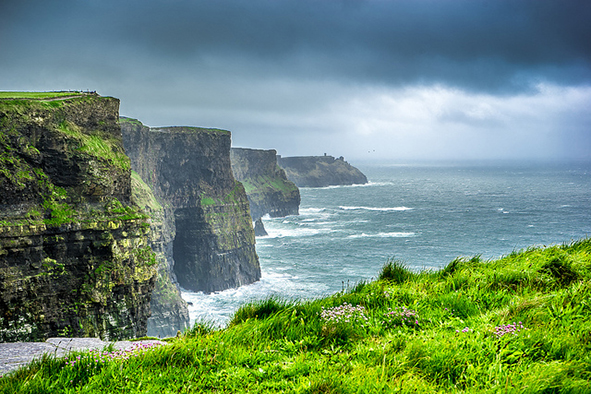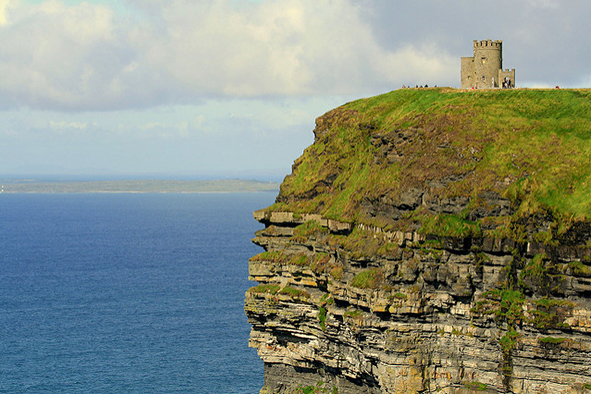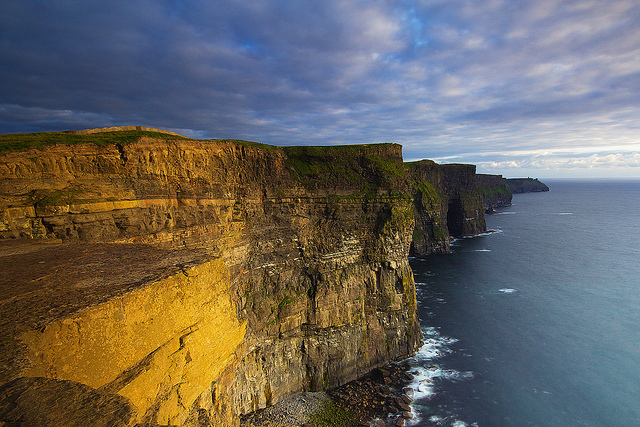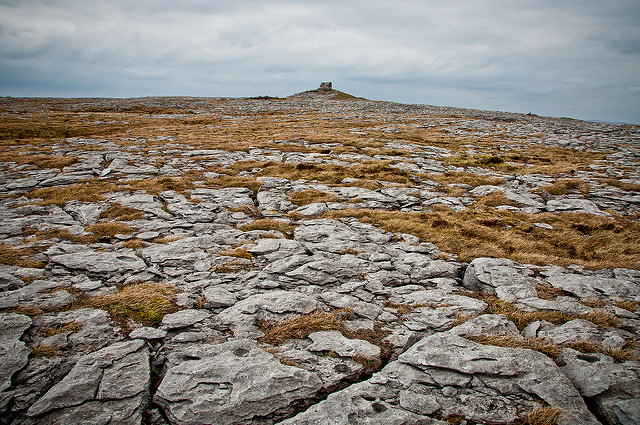The wild landscape of the Cliffs of Moher and the Burren has an ethereal, magical quality that captures the imagination and has inspired a wealth of intriguing folklore and fantastical tales.

The stunning Cliffs of Moher (Photo: Giuseppi Milo via Flickr)
I feel like I’m on the edge of the world.
The stony path along the cliff’s edge meanders before me and the winds synchronise with the crashing waves to create a howling soundtrack to my walk. The great expanse of the Atlantic Ocean stretches as far as the eye can see, all the way to the US.
This is my first venture to the UNESCO certified Burren and Cliffs of Moher Geopark in Co Clare, highlights of a coastal touring route along Ireland’s west coast that has become known as the Wild Atlantic Way. After some cursory research, these iconic landmarks and the mythology that has evolved around them had begun to fascinate me.
Literary inspiration
A haunting and untamed landscape, this windswept corner of Co Clare has long captivated poets, writers and artists including WB Yeats, Irish-Australian painter Sir Sidney Nolan, JM Synge and allegedly JRR Tolkien. Research by Tolkien scholars suggest the author of The Hobbit and The Lord of the Rings was probably influenced by the scenery and Celtic folklore during his stay in the west of Ireland in the 1950s.
While the Tolkien link may be unproven, there is no denying the magical quality that pervades the area. At the highest headland on the Cliffs, a Gothic viewing point known as O’ Brien’s Tower commands unparalleled views of spectacular scenery. Visibility can be temperamental on the cliffs but I am in luck; the sun emerges to reveal breathtaking sights of the Aran Islands and Galway Bay, the Twelve Pins and the Maum Turk mountains in Connemara, Loop Head, the Dingle Peninsula and the Blasket Islands in Kerry.
A bird swirls above me, a solitary ambassador for the thousands of seabirds that have made their home on the cliffs. Standing here, I think of the countless people who have been transfixed in this same spot gazing outwards, perhaps imagining a better life in the New World or just savouring the intoxicating beauty before them.

Hag’s Head at the Cliffs of Moher (Photo: razordu30 via Flickr)
Legends of the fall
Unsurprisingly, the otherworldly quality of the cliffs has inspired a host of fantastical tales ranging from the whimsical to the downright disturbing. Some of these legends have become immortalised in the names of its natural features. Just below the tower, a jagged rock juts out from the sea with a vaguely ominous air. Known as Hags Head, the rock is supposedly named after a lovelorn witch called Mal who fell head over heels for Celtic hero Cúchulainn. But proving that supernatural powers are no barrier to ill-advised romantic attachments, Mal chased the object of her unrequited affections all around Ireland until they reached the Cliffs of Moher.
Cúchulainn leapt to the island known as Diarmund and Grainne’s Rock with Mal in hot pursuit. Buoyed by a gust of wind, she leapt after him and the dashing warrior immediately leapt back. But on her second leap, the wind failed her and poor Mal fell and crashed onto the rocks below dyeing the waves crimson with her blood. According to the legend, she was transformed into a rather angry looking rock – serving as a cautionary tale about the perils of obsessive behaviour ever since.
From Hags Head the cliffs stretch 8km to Aill Na Searach or the Cliff of Foals, which derives its name from the story of how the mythical Celtic Gods, the Tuatha De Danann, met their end. After the invasion of Christianity, the magical people transformed into horses and took refuge in a cave near the cliffs for centuries. But when they finally emerged from the darkness; only seven foals remained. Dazzled by the sunlight, they galloped frenziedly along the edge of the cliffs before plummeting to their deaths. Academics have also made links between the tragic Tuatha De Danann and Tolkien’s mystical elvish people.
Other memorable folklore include tales of a fisherman who ensnared a mermaid by stealing her magic cloak and a giant killer eel that emerged from the ocean to wreak destruction before being killed by St Macreehy.

A ray of evening sun on the cliffs (Photo: Daniele Bellucci via Flickr)
A lost city
The midday sun casts a dazzling shimmer across the water reminding me of another intriguing myth; the lost underwater city of Kilstiffen. My imagination conjures up images of golden-roofed palaces, churches, and towers shining below the water’s surface. The story goes that the city sank when its chieftain lost a golden key to its gates condemning the city to its underwater fate until the key is restored once again. According to legend, the city rises above the water briefly once every seven years but anyone who is unfortunate enough to see it is doomed to die before it rises again.
Thankfully no such vista appears before me and I can depart from the cliffs, unperturbed, and make a short visit to the Visitor Experience Centre. Built into a hillside at the foot of the cliffs, its Atlantic Edge Exhibition has interactive media displays, images and features that offer an excellent insight into the geology, history, flora and fauna of the cliffs. After a restorative cup of tea in the café, it is time to explore the next stage of the journey; the mysterious Burren.
A half an hour drive from the cliffs, this stark and beautiful landscape derives its name from the Gaelic word “boireann” meaning rocky place. It is certainly apt; its unusual Karst topography was formed 320 million years ago under a tropical sea and has left a vast cracked pavement of glacial-era limestone.
A wander through the Burren offers the sense of being transported to another time or place. The surreal environs are a botanist’s dream with alpine and Mediterranean flora and fauna that grow alongside each other. Spanning 250 km, the Burren consists of cliffs and caves, fossils, rock formations and archaeological sites that date back as far as 5,000 years. Dotted with the remnants of ancient and medieval Ireland, the landscape includes megalithic tombs, Celtic crosses and tombs along with ring forts that operated as the tribal centres for the area’s chieftains in the early middle ages.
Other historical structures include the ruins of a Cistercian abbey and tower houses once used as strongholds by the great ruling families of the area, the O’Briens and the O’Loughlins, in the fifteenth and sixteenth centuries.

Sparse beauty of the Burren (Photo: Archigeek via Flickr)
Tolkien and the Burren
It is easy to see how its lunar beauty combined with its historical lore could have provided the inspiration for Tolkien’s terrifying and magical Middle Earth. The Gortaclare Mountains in particular are said to have been a potential inspiration for the forbidding Misty Mountains.
It has even been suggested by Tolkien aficionados that arguably his most disturbing character, Gollum, could be named after a cave in the Burren known as the Poll Na gColm. Although, its meaning in Gaelic is rather more innocuous than its alleged namesake – the Cave of the Doves. Such associations have given rise to the Burren Tolkien festival, which has been held in Co Clare over the past couple of years.
Silent save for the relentless whispers of the wind, the serenity of the Burren is in marked contrast with the bustling activity within a number of small villages that encircle it. One of them, Doolin, is my final destination. Known as the traditional music capital of Ireland, it has retained its quaint charm despite the tourist hordes and inevitable souvenir shops.
Exhausted after a long day of exploration, I make my way to the heart of the village to the invitingly cosy environs of Gus O‘ Connors pub. The evening promises refreshment and relaxation to the strains of lively tunes – the perfect place to unwind after a busy day traversing the dream-like terrain and to come back slowly, if somewhat reluctantly, to reality.
Further Information:
There is an entry fee to use the facilities at the cliffs including access to the Visitor Experience Centre and car parking. The adult entry fee is €6; disabled people, students and senior citizens €4; children are free.